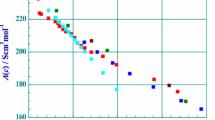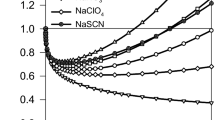Abstract
Graphs of the total radius (the distance between an anionic nuclei and a cationic nuclei in a crystal) of sodium halides and alkali metal fluorides versus total limiting equivalent conductivities were plotted. For the hard ions Na+ and F−, whose behaviour approaches a hard spherical model, it was determined that radii values could be obtained using differences in limiting equivalent conductivities and ionic crystal data. From the determined radii of sodium and fluoride ions and known crystal data, radii of other alkali metal halides were calculated.
Access this article
We’re sorry, something doesn't seem to be working properly.
Please try refreshing the page. If that doesn't work, please contact support so we can address the problem.

Similar content being viewed by others
Notes
When the dipoles of the water molecules are oriented exactly towards the positive charge of the cation, the potential energies of the water molecules in the first coordination sphere are much greater than the potential energies of free water molecules. Thus, when the dipole of the water molecule is oriented towards the centre of the positive charged ions, (r ion + r water)2 is inversely proportional to potential energy because the other parameters such as the dipole moment of water and the charge of the ion remain constant.
References
Bockris J’OM, Reddy AKN (1971) Modern electrochemistry, vol 1, 2nd edn. Plenum, New York
Conway BE (1981) Ionic hydration in chemistry and biophysics, 1st edn. Elsevier, Amsterdam
Yıldıran-Tunçgenç (1981) MS thesis, Ege University, Izmir, Turkey
Lande A (1920) Z Phys 191:1
Wasastjerna JA (1923) Soc Sci Fenn Comm Phys Math 38:1
Morris DFC (1968) Struct Bond 4:63
Fumi FG, Tosi MP (1964) J Phys Chem Solids 25:45
Pauling L (1960) The nature of the chemical bond. Cornell University Press, Ithaca, pp 517–518
Harvey K, Porter GB (1963) Introduction to physical inorganic chemistry. Addison-Wesley, Massachusetts, pp 22–24
Ayata S (2007) Chem Eng Commun (in press)
Robinson RA, Stokes RH (1959) Electrolyte solutions. Butterworths, London
Acknowledgements
We would like to thank S. Astley from Ege University, Izmir for helpful comments.
Author information
Authors and Affiliations
Corresponding author
Rights and permissions
About this article
Cite this article
Yıldıran, H., Ayata, S. & Tunçgenç, M. A theoretical study on calculation of ionic radii using limiting equivalent conductivities. Ionics 13, 83–86 (2007). https://doi.org/10.1007/s11581-007-0078-y
Received:
Revised:
Accepted:
Published:
Issue Date:
DOI: https://doi.org/10.1007/s11581-007-0078-y




